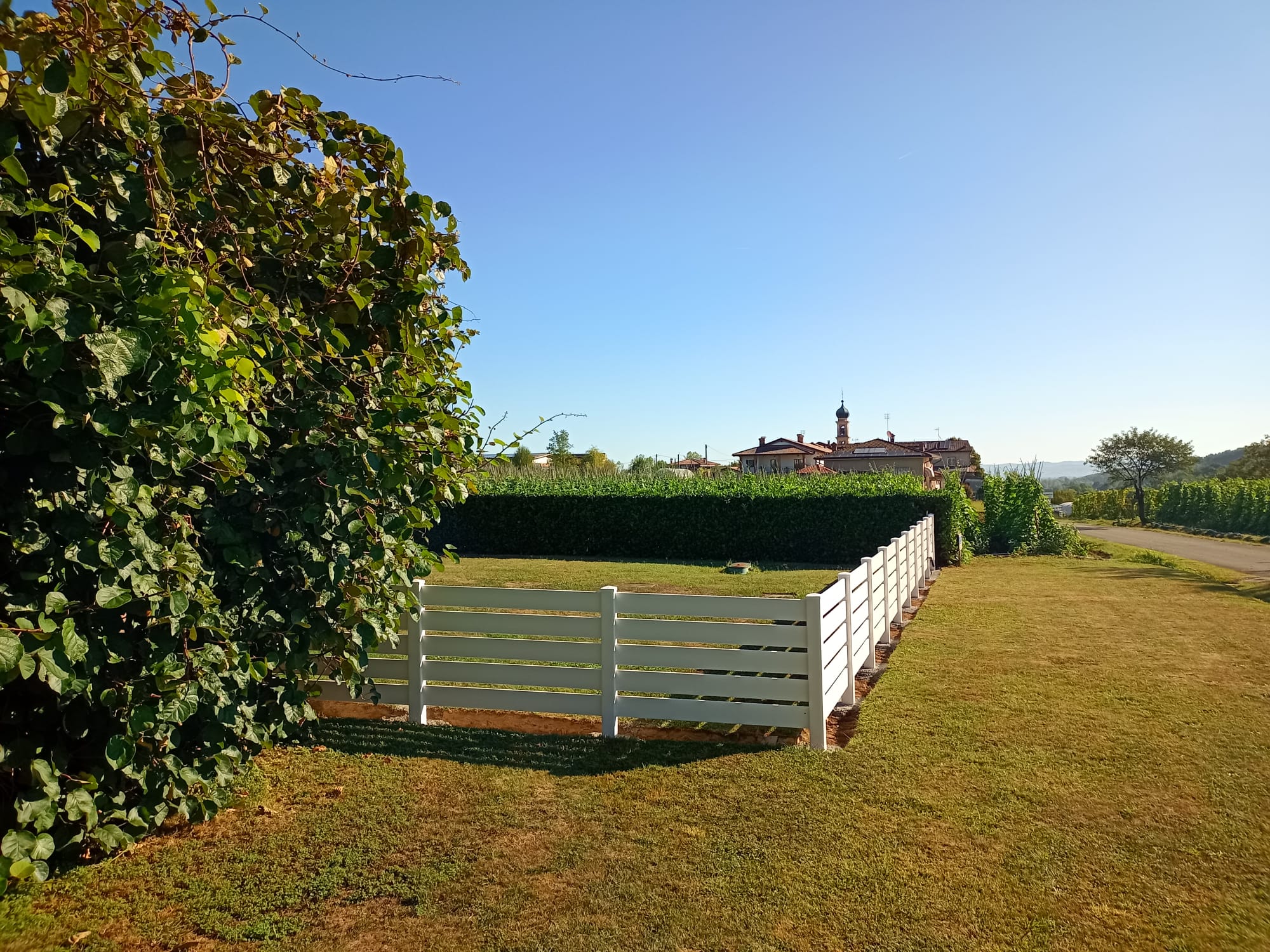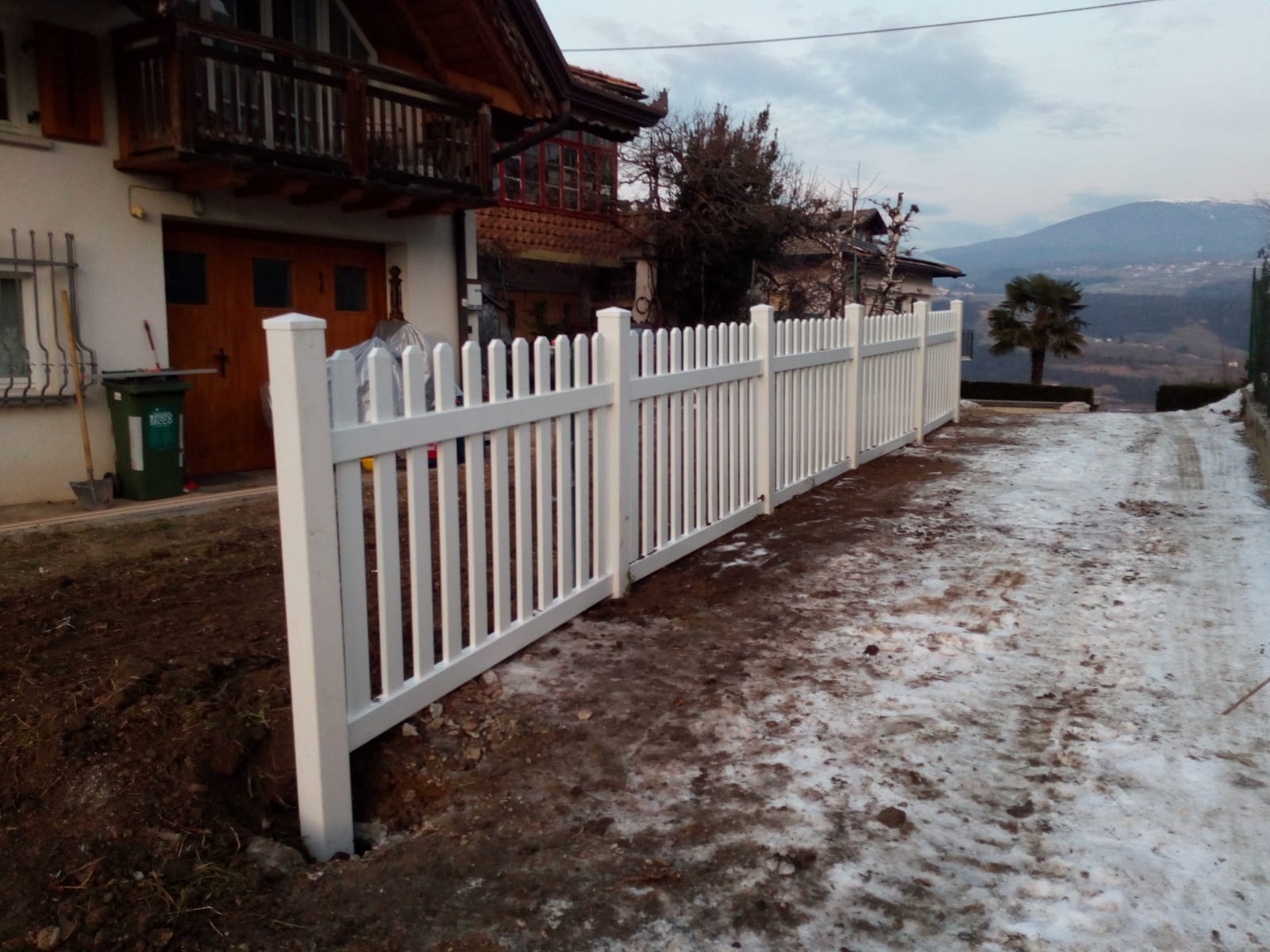Aesthetics compared: what to choose for a clean style
Do you dream of an outdoor space that conveys order, elegance, and a sense of peace every time you step into it? Welcome to the world of minimal garden design, where every detail has its purpose and nothing is left to chance. When it comes to clean style, everything starts with a simple yet fundamental question: which material should you choose for your fence? Sounds trivial, right? But the truth is, the fence plays a huge aesthetic role—even if it’s often underestimated. To help you choose, let’s compare three classic contenders: wood, iron, and PVC. Spoiler: there’s no one-size-fits-all answer, but there’s definitely the perfect one for you.The charm of wood (but watch out for the maintenance)
Wood is the timeless classic. If you love natural and warm materials, you’ve probably already considered it. It immediately gives you a sense of coziness, elegant rusticity, and fits well with more “country” or traditional gardens. But if your goal is a clean, linear aesthetic—and especially hassle-free—then you might have some second thoughts. Wood is alive, and that’s also its strength. But… it’s also its weakness. Over time it changes color, absorbs moisture, and if you don’t treat it regularly, it deteriorates. Do you really want to spend every spring painting, treating, and checking for mold? Sure, there are treated or heat-treated woods that last longer, but they are often much more expensive. And even if you choose a light wood, keeping it truly light over time is a task for zen gardeners. In short: beautiful, yes. But impractical for those who love order without too many complications.Iron: modern yes, but… watch out for rust
Iron is often seen as a “design” choice, especially when we talk about models painted black or dark gray. Straight lines, solid structure, a certain industrial touch that urban minimalism lovers can really appreciate. And then there’s the feeling of solidity: an iron fence makes a statement and protects with strength. But there’s a catch. Actually, more than one. Iron, as you well know, doesn’t like moisture. If you live in a rainy, humid area or near the sea, sooner or later you’ll have to deal with rust. Even with rust-proof paint, maintenance is needed: checking, scraping, touching up. Sometimes it needs to be redone from scratch. Aesthetically, iron also has a “colder” look, and it doesn’t always blend well with a softer Nordic style. If your dream is a minimalist, orderly garden with light colors, iron can feel a bit too harsh. And the risk is that it quickly goes from “modern and clean” to “industrial and dull.”PVC: clean, simple, and (finally) beautiful
PVC is often underestimated because many associate it with cheap or ugly products. But beware: times have changed. Today, there are PVC fences that are a tribute to modern design, with straight lines, matte finishes, and refined colors. And the best part is you can have it all: clean style, durability, and almost no maintenance. Imagine a matte white fence, with perfectly symmetrical vertical or horizontal slats, installed invisibly. Or an anthracite gray fence that matches the house windows, patio floor, and concrete pots. Well, today PVC lets you bring these ideas to life effortlessly and without breaking the bank. It doesn’t fade, it doesn’t warp, and it doesn’t need painting. You clean it with a damp cloth or at most with a water spray. It’s resistant to sun, rain, and salt air. And the aesthetic part? There are minimal, geometric, essential models. Just the way you like them. Not only that: you can choose modular fences, easy to install, perfect for creating a neat and contemporary look. An advantage for those who love weekend “chic DIY,” but also for those who prefer to rely on a professional installer.So… what to choose?
If you love a rustic atmosphere and don’t mind spending time on maintenance, wood is always a romantic choice. If you want a bold, almost urban style and can invest a bit in treatments, iron can give a strong character. But if your dream is an elegant, orderly, modern garden that’s easy to manage, PVC will give you great satisfaction. And no, we’re not talking about that cheap “plastic” PVC from the supermarket. We’re talking about architectural PVC, designed for those who love design and want to feel it even in the garden.After all, even a fence can be an aesthetic gesture. A line that separates… with style.
Maintenance, durability, and sustainability: what really matters in your modern garden?
If you’re designing your outdoor space in a minimal style, you’re probably looking for not just beauty but also practicality and durability. You want something that stays beautiful over time, without becoming a problem or a constant expense, right? In a modern garden, where every element is carefully chosen, maintenance matters as much as design. Actually, for many, it is precisely maintenance that makes the difference between a dream garden and a weekend nightmare. Let’s see together how the most used materials for fences (wood, iron, and PVC) behave, not only aesthetically but also in terms of long-term maintenance.When beauty requires effort: the truth about maintenance
Let’s start with a simple question: do you want a garden to enjoy or to manage like a second job? If you’re on the “no hassle” team, certain solutions might soon seem less appealing than they do at first. Wood, for example, has a warm and natural look, but it needs constant care. And by care, we mean: sanding, painting, protecting, checking that it doesn’t rot or get attacked by woodworms. Every year – or every two, if you’re lucky – you have to factor in time, products, and some grumbling. And if you skip a treatment? Your beautiful fence will break, fade, or start crumbling like a cookie left out in the air. Iron, on the other hand, is solid and visually strong, but… it has a historic enemy: rust. Even if you choose galvanized or painted models, sooner or later you’ll have to use a brush and rust-proofing. And if you live in a humid area or near the sea, get ready: maintenance will be even more frequent. Then there’s PVC, often underrated but surprisingly practical. It doesn’t crack, fade, rust, and above all, it doesn’t force you to intervene every spring. You clean it with water, some soap, and maybe a soft cloth. End of story.Durability over time: who really wins?
When you invest in a fence, you don’t want to replace it in 3 years or have to repair it every summer. Your goal is simple: something that lasts and stays beautiful without dramatic effort. Wood, if well and regularly cared for, can last up to 15 years. But the secret is exactly that “if cared for well”: without maintenance, it collapses in a few winters. And even with all the attention in the world, it will change color and take on a worn look that you might no longer like. Iron lasts a very long time if treated periodically, otherwise it can corrode surprisingly quickly. There are cases where galvanized iron fences have lasted up to 20 years, but… do you know how many cans of rust-proofing that takes? PVC, on the other hand, is designed to last over time. Modern, high-quality versions are guaranteed for over 15 years and withstand sun, rain, frost, and salt air. It doesn’t warp, change color, or force you to fix things at the last minute. In short, if you think in terms of “design + zero stress,” PVC has a clear advantage to play.Sustainability: can beauty and respect for the environment coexist?
Today, sustainable design is talked about more and more, and it’s not just a magazine trend: it’s a real priority. And the good news is that you can have a modern, well-kept, and environmentally friendly garden without sacrificing style or comfort. Wood is natural, of course, but only if it comes from responsibly managed forests. Moreover, the chemical treatments needed to protect it often have an environmental impact that’s far from negligible. Paints, preservatives, and anti-woodworm products contain substances that, over time, end up in the soil or the air. Iron can be recycled and therefore has some “green” value, but its production is energy-intensive and not very sustainable. Moreover, rust-proof treatments often involve the use of solvents and chemical products. PVC is often demonized, but when it comes to high-quality, recyclable PVC, the story changes. Today, there are PVC fences that are fully recyclable, produced with less impactful processes and free from toxic substances. And since they last a long time and don’t require harmful maintenance, their environmental impact is significantly lower in the long run. An extra advantage? When you choose a sustainable PVC fence, you’re also reducing the consumption cycle and the waste generated. In practice: less waste, fewer chemicals, fewer hassles.Which materials age better over time?
You’ve finally found the right style for your garden: clean lines, neutral colors, a contemporary look that reflects you. Now you just need one thing: to choose the perfect material for your fence, and you want something that lasts over time. You don’t want to see your fence turn into something sad, faded, or damaged after a couple of years, right? In this article, I take you on a little journey through wood, iron, and PVC to see which truly ages well. Like those people who become more charming with age… let’s see if materials can do the same!Wood: beautiful when first installed, but requires continuous care
Wood is a very popular choice, especially for those looking for a natural touch and a warm, cozy aesthetic. When you install it for the first time, the result is truly beautiful: it smells of nature and blends with any garden. But then autumn comes, the rain, the summer sun, March humidity… and the wood starts to change appearance. If you don’t treat it regularly, it begins to fade, crack, and lose all that beauty that had won you over. Over time, it tends to change color, sometimes pleasantly, but often in an uncontrollable way. It turns gray, stained, or worse, cracks and fissures form where water seeps in. Does it age? Yes. But only if you take constant care of it; otherwise, it becomes a pain. And even if you love it, after a few years it might seem much less “zen” and much more “extra work.”Iron: strong and bold, but rust doesn’t forgive.
Iron immediately gives an image of solidity, minimal elegance, and an almost industrial style that many design enthusiasts like. Properly installed, with straight lines and dark colors, it can be a great ally for a modern and clean look. But iron also has a fragile side: humidity is its worst enemy. Over time, even painted or galvanized models risk showing the first signs of rust. And from there on, you enter a cycle of inspections, sanding, rust-proofing, and periodic repainting. Aesthetically, a rusty iron fence quickly loses its charm and looks neglected even if you installed it recently. In very humid areas or near the sea, deterioration can be even faster, even with the best initial care. Iron can age well only if protected consistently, but maintenance becomes unavoidable. And if you’re looking for a style that stays perfect without stress, you might change your mind along the way.PVC: ages little, and that’s a big advantage.
And now we come to PVC, often considered a “cold” material, but which has made great strides in recent years. Today, there are PVC fences with modern finishes, clean lines, and surprising resistance to the passage of time. Unlike wood and iron, PVC doesn’t absorb moisture, doesn’t rust, and doesn’t change color noticeably. You can choose shades like matte white or anthracite gray, and after five or ten years it will still be there, unchanged. It doesn’t warp in the heat, swell with rain, or crack in the frost. For this reason, those who love order and minimal design often prefer it without hesitation. Want to know the best part? You practically don’t have to do anything to keep it in shape. A rinse with water and it looks like new, no treatments or painting needed. Does it age? Sure, but it does so quietly, almost invisibly, and that’s what makes it so suited for real life. It lasts over time without driving you crazy, making it the best friend of minimalist design.An honest comparison for those who love beauty that lasts
If you’re looking for a fence that ages like fine wine, you should look beyond the initial aesthetics. The real question is: in five or ten years, will it still be as beautiful as it is today?- Wood can give you strong visual emotions, but it only ages well if you constantly pamper it.
- Iron has a strong personality, but it needs care and specific products to withstand time.
- PVC, with its clean style and minimal maintenance, is made for those who want lasting beauty without complications.
When (and why) PVC is the most sensible choice
If you’re thinking about a new fence for your garden, you’ve probably already considered a long list of materials. Wood, iron, maybe even aluminum. But there’s one material that, in recent years, has gained more and more fans: PVC. Yes, you heard right: that lightweight, modern, and super durable material that’s no longer used just for pipes or windows. PVC fences are becoming the favorite choice for those who love a clean, linear, and contemporary aesthetic. And if you’re looking for a solution that’s beautiful, practical, and long-lasting, you might find that PVC is exactly what you need.If you love minimal aesthetics, PVC will make your eyes shine.
Imagine a fence with straight, essential lines, perfectly symmetrical. No frills, no odd curves, no clashing colors or finishes that ruin the visual harmony. Just pure order and style. There you have it: this is the world of outdoor PVC, designed for those who love Nordic design and a modern look. White or anthracite gray PVC fences blend perfectly with modern facades, minimal windows, and well-kept green spaces. They don’t look “plasticky” as you might fear: the matte finishes and contemporary design make them truly elegant. You look at them and wonder: “Why didn’t anyone tell me this before?” If you’ve invested time and money to create a neat and coherent garden, a PVC fence enhances it without overpowering it. It makes the space brighter, airier, more geometric. And it does all this… without asking anything in return (we’ll get to that shortly).When you want zero worries, it’s the perfect choice.
Let’s be honest: how many times have you wished for a home and garden that don’t require constant work? With wood, you have to paint, protect, repair. With iron, you fight rust and the marks of time. With PVC, instead, a wipe with a cloth or a spray of water is enough to make it look perfect again. It’s the ideal material for those who love visual and mental cleanliness. It doesn’t chip, fade, or warp. And above all, it requires no maintenance. It lets you enjoy the garden as a space for relaxation, not duties.No special equipment needed, no costly treatments, you don’t have to become an expert in paints and preservatives. You install your fence, enjoy it, and for years… you forget about it. And honestly, it’s a relief. If you have a hectic lifestyle, work all day, and just want to come home to a tidy space, PVC is the silent ally working for you while you enjoy your weekend.







Leave A Comment